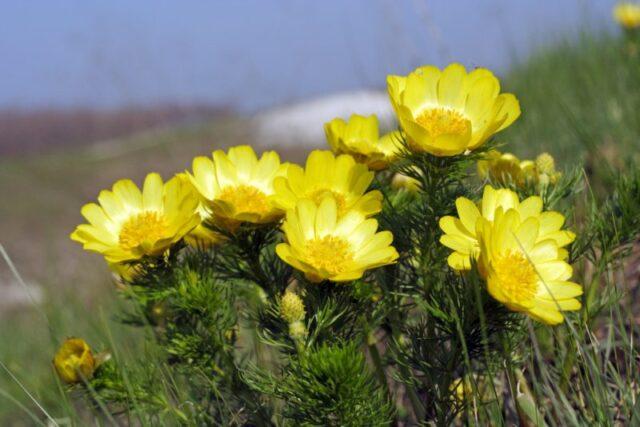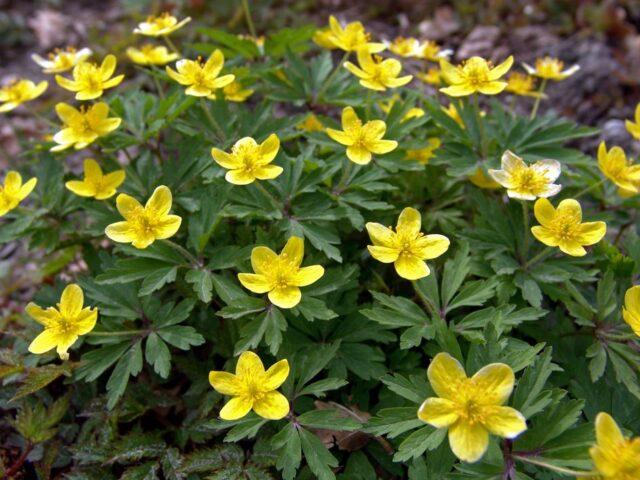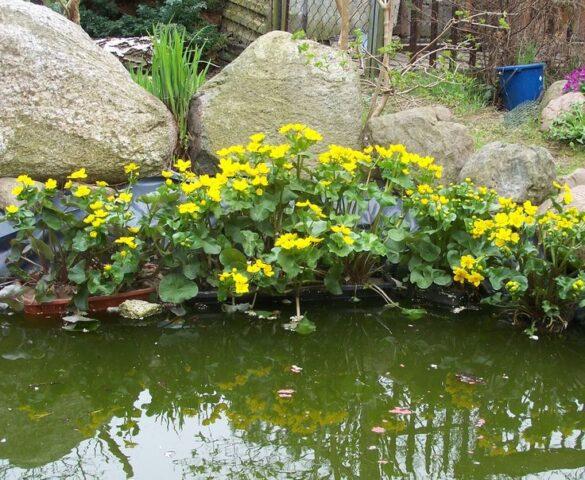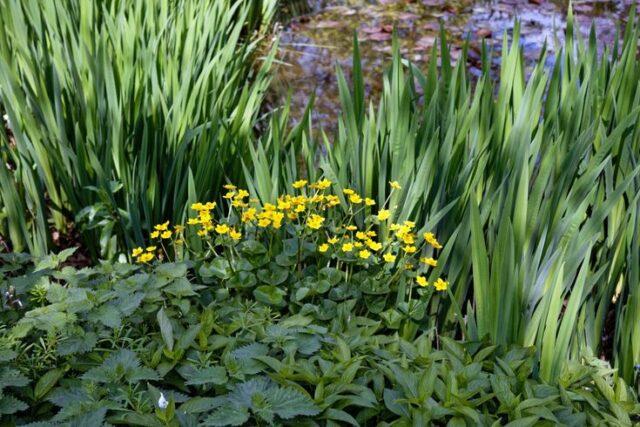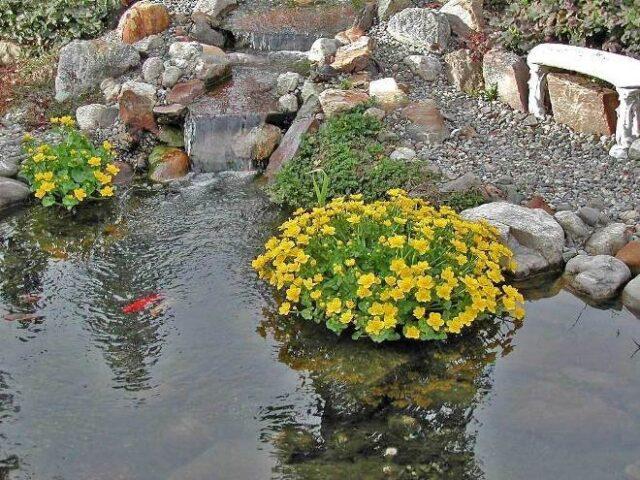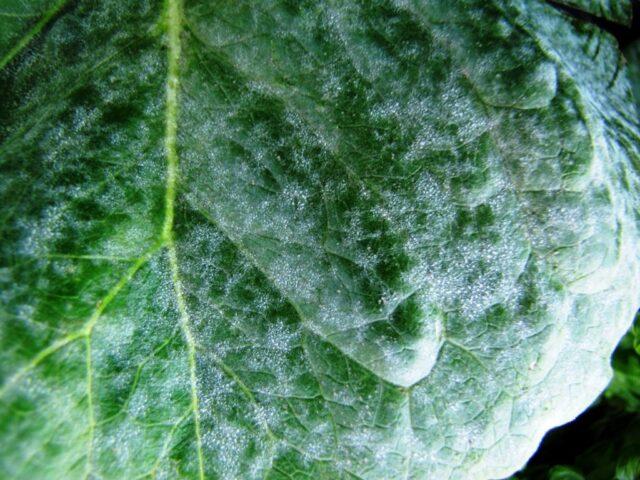Content
- 1 Botanical description of marigold
- 2 Description of the marsh marigold
- 3 Other species and varieties
- 4 Application in landscape design
- 5 Breeding features
- 6 Landing rules
- 7 Care features
- 8 Pests and diseases
- 9 Conclusion
Marsh marigold is a plant with valuable decorative characteristics and medicinal properties. Before planting a perennial in the country, you need to study its varieties and features.
Botanical description of marigold
Marsh marigold (Caltha palustris) is a herbaceous perennial from the Buttercup family up to 40 cm tall. It has a straight and thick succulent hollow stem, branched closer to the apex. In the photo of the marsh marigold, it can be seen that the leaves of the plant are leathery, whole, arranged in regular order, very large at the roots.

The surface plates of the marigold are dark green, the underwater ones can be red-purple
What do marigold flowers look like
The plant blooms with numerous flowers, collected in rare inflorescences, twice a season - in April and May and in autumn. Each of the buds reaches up to 4 cm in diameter. A photo of the color of marigold demonstrates that the plant has a rich golden-yellow hue during the decorative period. In September, the perennial bears fruit - dry leaflets with black shiny seeds.

The petals of the marigold plant are characterized by a varnish sheen
Distribution area
The plant is distinguished by its hardiness and winter hardiness. You can see it in the European part of Russia and the Caucasus, in Siberia and the Far East, in Central Asia. Perennial is often found in swamps and along the shores of lakes and rivers. The adaptation of the marigold to water allows it to grow directly in ponds and streams at a depth of about 20 cm.
Description of the marsh marigold
To appreciate the properties of a plant, you need to familiarize yourself with its unique characteristics. The latter include not only external features, but also applications.
What flowers look like marsh marigold
In the absence of experience, perennials can be confused with other plants. Kaluzhnitsa is similar to:
- spring forest poppy;
You can distinguish the spring poppy by the shape of the leaves
- pungent buttercup;
Unlike marigold, pungent buttercup has thin, dissected leaves.
- European swimsuit;
The European swimsuit has a more complex bud structure than the marigold
- spring adonis;
Spring adonis leaves are very small and thin
- spring cleaner;
The petals of the spring peel are longer and narrower than those of the marigold
- buttercup anemone.
You can recognize the buttercup anemone by its finger-dissected leaves.
It is easy to distinguish plants from each other if you carefully study the photos and descriptions of the species in advance.
The degree of toxicity
Kaluzhnitsa belongs to the category of poisonous plants - all of its fresh parts are toxic. Perennial juice gives off an unpleasant odor and has a very sour taste. Grass is not eaten by animals grazing near swamps and water bodies.
The plant contains palustrolide and epicaltolide, as well as a large amount of alkaloids, coumarins, protoanemonins. Careless consumption of fresh marigold leads to intoxication.
Signs of poisoning
Symptoms of poisoning appear on average two hours after the plant is used for food. Intoxication is expressed by severe weakness, dizziness, nausea and vomiting, abdominal pain and diarrhea. Some patients have more frequent urination.
In case of plant poisoning, it is necessary to drink plenty of plain water and artificially induce vomiting to cleanse the stomach. After that, you should take activated charcoal and go to a medical facility.
The sap of the plant is also irritating when it comes into contact with the skin. In this case, rinse the affected area with warm water, and then take one of the antihistamines.
Medicinal properties of marsh marigold
Despite its toxicity, the plant has medicinal properties. Saponins in perennials are beneficial in the treatment of coughs and bronchitis. Flavonoids in the grass and roots have a beneficial effect on blood vessels, even out the heart rate and stabilize blood pressure. The plant is taken for inflammation and pain relief.
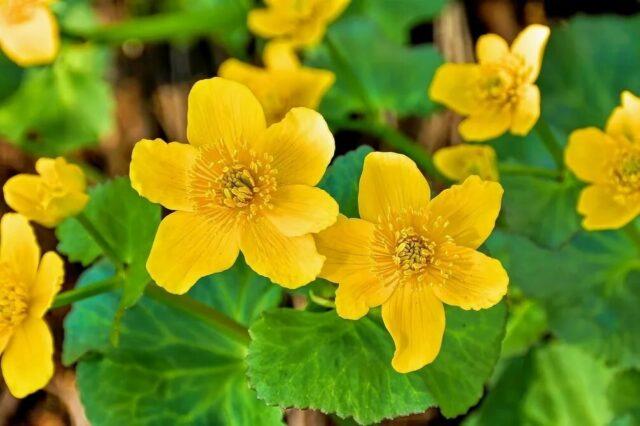
In small dosages, marigold is used for the prevention of cancer
Application in traditional medicine
Traditional medicine offers several recipes based on a perennial plant. When using medicinal products, it is very important to follow the recommended dosages and admission rules.
Decoction for colds
With ARVI and influenza, traditional medicine recommends the following perennial-based remedy for use:
- the roots of the plant are crushed in the volume of a small spoon;
- pour 250 ml of water;
- in an enamel bowl, boil under a lid for half an hour over low heat.
The product is cooled and passed through cheesecloth, squeezing the raw material. The resulting liquid is topped up with clean water to the original volume and taken four times a day in a large spoon. You need to consume a medicine based on a plant on a full stomach.
With prostatitis
The roots of the medicinal plant are good at relieving inflammation in prostatitis. The remedy is done like this:
- 1/2 small spoon of chopped rhizomes are poured with a glass of water;
- boil over medium heat for five minutes;
- removed from the stove and insisted for another hour.
The filtered drug is taken up to four times a day for 1/4 cup, the total treatment is continued for up to three weeks.
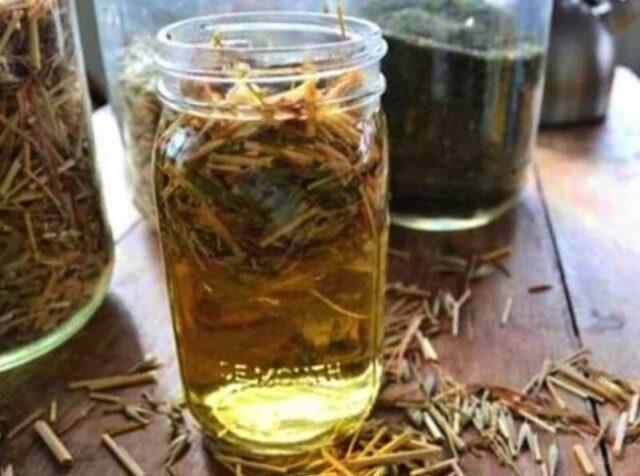
A decoction of marigold root has analgesic properties
With a fever
An infusion of the leaves of the plant helps to cope with heat and fever. Prepare it like this:
- a small spoonful of raw materials is poured into 200 ml of boiling water;
- keep under the lid for an hour;
- filtered through cheesecloth.
Take the remedy for 1/3 cup three times a day with food.
Collection and procurement of raw materials
Harvesting of marigold roots is carried out in late autumn, shortly before the cold weather, when the plant finally fades away. Leaves and stems are harvested in the spring at the beginning of bud opening. Any parts of the plant are first washed in cold water and then dried in the fresh air or in an oven at 45 ° C until the moisture has completely evaporated.
It is necessary to store raw materials in paper bags or glass containers in a dark place with low humidity. The harvested plant retains medicinal properties for two years.
Cooking applications
Perennial, subject to careful culinary processing, can be used in the preparation of edible dishes. From the buds of the plant, they make a marinade for fish and meat, leaves are added to soups to improve the taste.
There is a Korean marigold recipe. The herb is first soaked in water for at least a day, periodically changing the liquid, and then boiled and mixed with sugar, garlic, spices, fried onions and soy sauce. A plant-based dish is especially tasty when you add nuts, sesame seeds and any greens. You can use it, including to improve your appetite.
Another recipe suggests making capers from plant buds. In this case, the unblown flowers are pickled in vinegar with soda, pepper and spices.
Other species and varieties
Kaluzhnitsa is represented not only by the marsh variety, but also by other wild and garden forms. It is interesting to study their photos and main features.
Terry marigold
Terry marsh marigold Plena (Caltha Palustris Flore Pleno) is an ornamental garden form of a plant. It differs in miniature dimensions and rises only up to 25 cm above the ground, develops much more slowly than the wild variety. Of interest are photos of marigold flowers that bloom on shoots in May. The buds are large, double in structure and bright yellow, hanging from the bush to the sides in voluminous bunches.
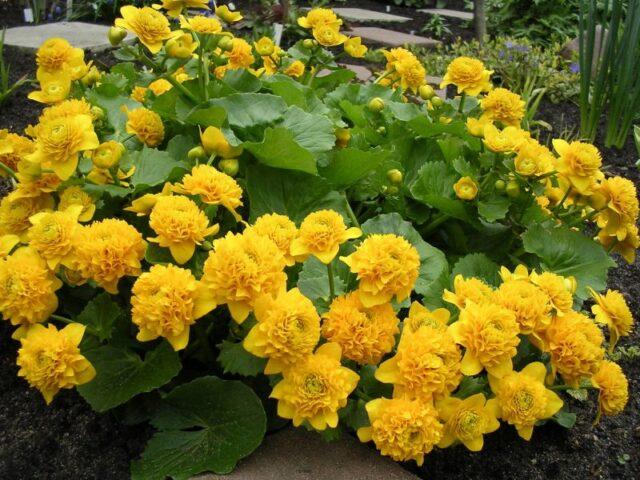
The structure of flowers in the terry variety Plena is more complex than that of wild species
Membranous
The membranous marigold (Caltha membranacea) rises by an average of 30 cm, has dark green large leaves on long petioles. In spring, the plant bears numerous small bright yellow flowers.
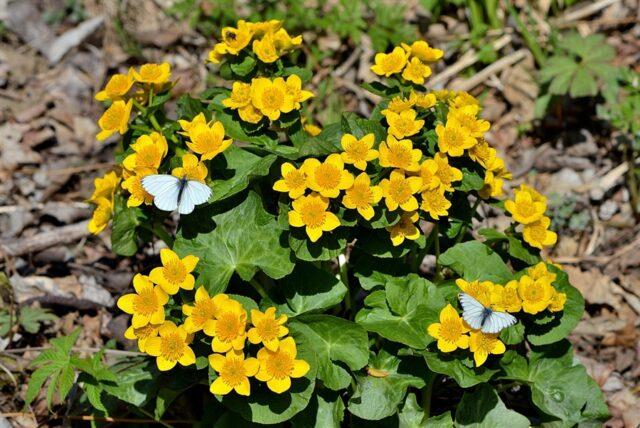
More than 20 flowers can bloom on one webbed marigold at a time
Fine petaled
Fine-petaled marigold (Caltha leptosepala) is a short grass with a straight, smooth stem. It has dark green leaves on petioles up to 25 cm. Photos of the marigold plant show that the buds of the species are white, small, up to 2 cm in diameter, on one peduncle there can be two pieces at once.
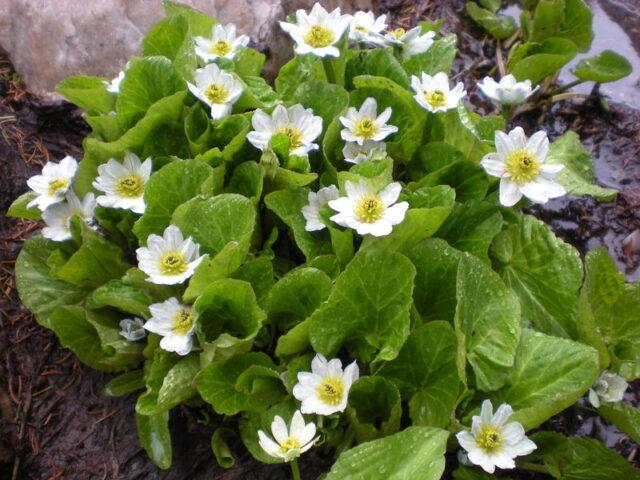
Fine-petal marigold grows on average up to 35 cm
Floating marigold
The floating marigold (Caltha natans) is a miniature variety with white flowers up to 4 cm in diameter. The leaf plates of the plant are rounded, with an even edge, about 3 cm wide, stick to the surface of the water.

The floating marigold is often used to decorate water bodies.
Forest
Forest marigold (Caltha sylvestris) belongs to the tall varieties and can reach 1.5 m. The leaves of the plant are round or kidney-shaped, up to 15 cm wide. Flowers are yellow, small, appear in April and May.
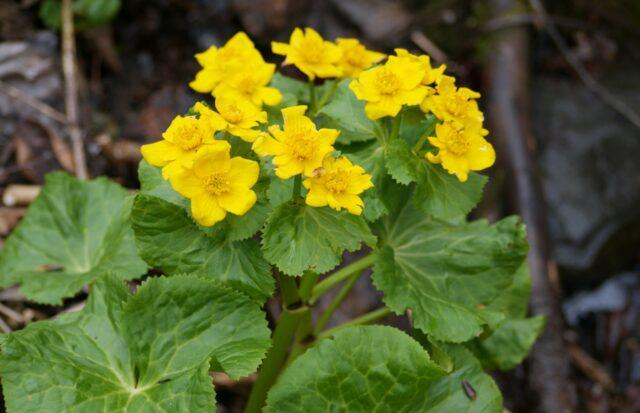
Forest marigold buds are collected in inflorescences up to 15 pieces
Fisty marigold
Fisty marigold (Caltha fistulosa) reaches 1.2 m above the ground by the time the seeds ripen, although during flowering it rises only up to 30 cm.The plant's stem is thick, the leaves are large and leathery, up to 15 cm in diameter. The yellow marigold blooms at the end of May with medium-sized buds, abundantly covering the bush.
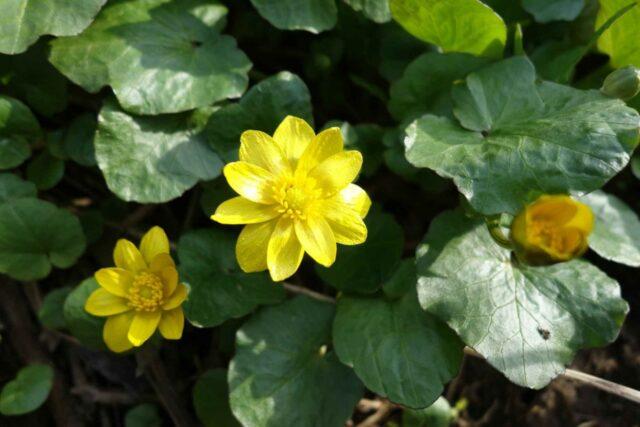
Loose flowers of the fistus marigold reach 7 cm in diameter
Two-flowered
The two-flowered marigold (Caltha biflora) is a compact shrub only about 10 cm tall. The plant has smooth, heart-shaped leaves up to 7 cm in diameter; in May, it bears small white buds that rise on long peduncles.
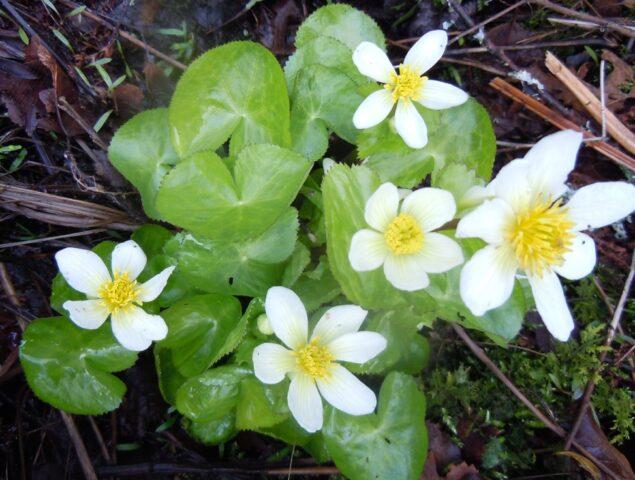
The homeland of the two-flowered species is North America.
Application in landscape design
A perennial loves a large amount of moisture, so it is usually used in swampy areas and in places where groundwater is close. The plant is used:
- for decorating the banks of reservoirs;
Kaluzhnitsa well emphasizes the line of streams and ponds in the garden
- for landing in artistic compositions imitating a forest glade;
Kaluzhnitsa looks favorably in densely shaded areas of the garden
- for placement directly on the surface of the water;
With the help of a marigold, you can romantically decorate an artificial lake in the garden
Kaluzhnitsa looks attractive next to ferns and irises, loosestrife and delphinium. It can be planted next to lungwort, incense, swimsuit and host. Plants will be able to bloom in turn, and the decorativeness of the flower bed will be maintained continuously.
Breeding features
The herbaceous plant is propagated both by seeds and by vegetative methods:
- By dividing the bush... An adult specimen is dug up in early spring or in September after flowering and the root is cut into several pieces with a sharpened shovel. Delenki are planted in selected areas of the garden. After the procedure, the plant only needs to be shaded and watered well. It tolerates division well and quickly takes root in a new place.
- Seeds... In spring or autumn, the planting material is first placed in the cold up to 10 ° C for 30 days, and then germinated for another two months at a temperature of about 20 ° C. After that, young plants can be planted in open ground, they will be able to bloom in three years.
- Layers... The fastest way is to bend the stalk of a perennial with a leaf bud to the ground, fix it and regularly moisten it for several weeks. Once the shoot is rooted, it can be detached from the mother plant and transferred to a new location.
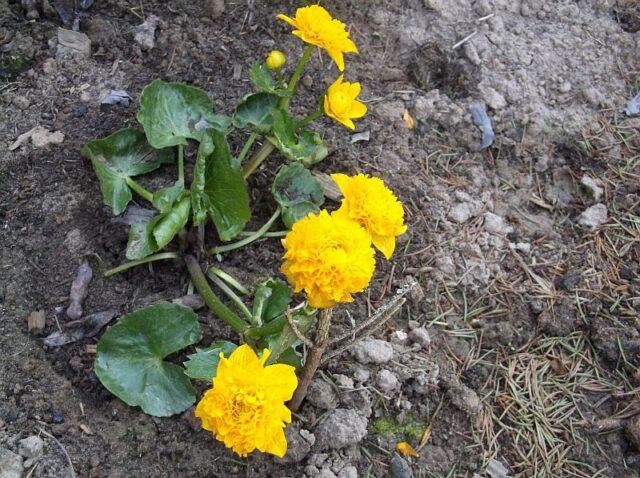
For propagation of marigolds, usually the division of the bush is used - the result is obtained the fastest.
Marsh marigold is distinguished by good endurance and is easy to reproduce by any means.
Landing rules
It is recommended to plant the plant in open ground in early spring or early autumn. Culture soil needs fertile, abundantly moisturized. A perennial is capable of growing both in open sunny places and in the shade under the cover of deciduous trees.
To plant marigold in the selected area, you need to dig a small hole, twice the size of the plant roots. Dry soil, if necessary, is diluted with clay, peat and humus. The seedling is lowered into a hole and its roots are covered with earth, and then the soil is slightly pressed against the stem. For the first time, the perennial must be shaded from the south side of the sunlight and ensure stable watering.
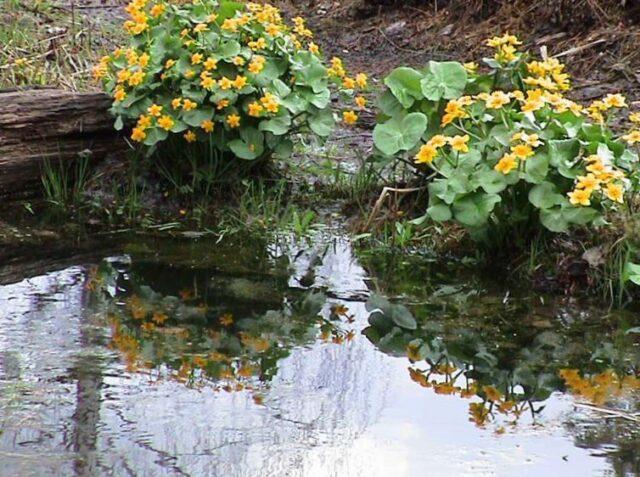
When planting near water, marigold does not require frequent watering, even in hot weather
Care features
Planting and caring for a terry marigold is not particularly difficult. The gardener only needs to worry about regularly moistening the soil in the summer. From time to time, it is recommended to loosen the soil at the roots of a perennial and remove weeds.
Plant feeding is carried out three times per season - at the beginning of spring, during the flowering period and in the middle of summer. You need to use complex mineral fertilizers containing nitrogen, potassium and phosphorus. Every 3-4 years, the perennial is transplanted by dividing the rhizome, as it grows and gradually loses its decorative effect.
The hardy marsh marigold does not need a winter shelter. But if desired, shortly before the onset of cold weather, the plant in the ground can be thrown with fallen leaves. This will insulate the root system and protect it from frost.
Pests and diseases
In general, a perennial plant is considered resistant to ailments and pests. But since it chooses wet areas for life, sometimes leaves and shoots can suffer from fungi.
- Rust... The disease can be recognized by the tarnishing of the plates and the appearance of brown spots of different sizes.
Rust responds well to copper sulfate treatment
- Powdery mildew... The lower plates of the plant are the first to suffer from the disease, then light spots spread to the upper parts.
Powdery mildew fungus leaves a white coating with transparent drops on the leaves
You can get rid of marigold diseases with the help of Fundazole and biological products Gamair and Fitosporin-M. The treatment of the plant is carried out in accordance with the instructions several times per season at intervals of 2-3 weeks.
Pests infest marsh marigold extremely rarely. Sometimes a perennial suffers from flies laying eggs on succulent leaf plates. You can get rid of insects with a mild soap solution.
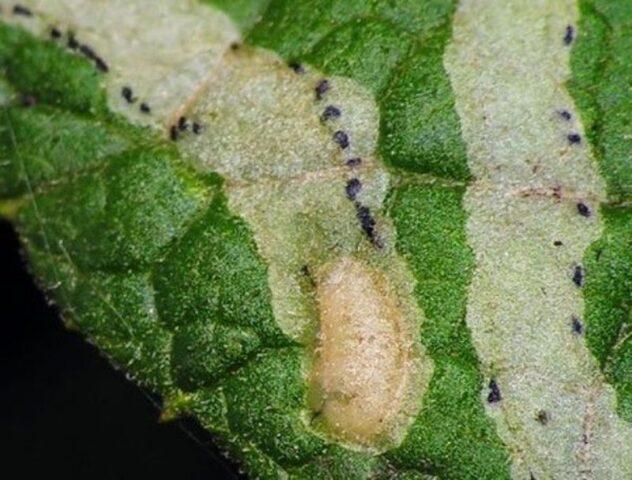
After hatching, the fly larvae begin to eat the juicy greens of the marigold
Conclusion
Marsh marigold is a very beautiful, hardy and easy to reproduce perennial flower. It can be planted in well-moistened areas and directly in water, the plant has medicinal properties. When applying, it should be borne in mind that marigold is poisonous, it is allowed to use it for medicinal purposes only in accordance with recipes.



